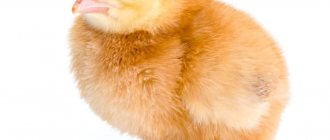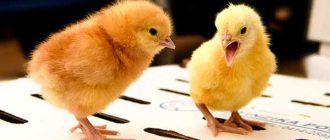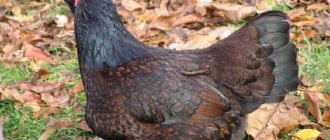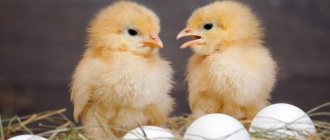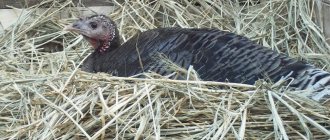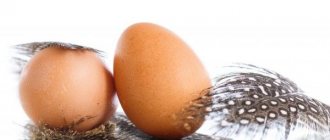Poultry farming » Chickens
1
8263
Article rating
Kira Stoletova
In order for birds to grow strong and healthy, you need to know the intricacies of raising them. What to feed chickens from the first days of life? We will analyze the physiological characteristics of young chickens, and also suggest the optimal diet for them at different stages of growing up.
What to feed chickens from the first days of life
Soldering
Chickens cannot be raised without ordinary, clean water, and for chicks it should be provided in small quantities on the first day.
For starters, a 0.5-1 liter jar, inverted into a special drinking bowl with a dispenser, is suitable. It is recommended to feed chickens with a weak pale pink solution of manganese in the first week - this will ensure the prevention of intestinal disorders. For the same purpose, children are given boiled water or diluted decoctions of chamomile, calendula, and yarrow. The drink should not be cold (not lower than 19-20 degrees). Some poultry farmers prefer to immediately treat day-old chicks with antibiotics. This will improve the health of the chicks and avoid many problems. Along with antibiotics, probiotics are also given. This must be done correctly, following the dosages. For questions related to medications and dosages suitable for feeding babies, it is better to consult a specialist.
Vaccination
Vaccination of livestock is a very important process, since many drugs are derived specifically from maternal antibodies. As a result, each chicken receives reliable protection against diseases.
Vaccination, depending on the drug used, is carried out in two ways - by drinking or by injection.
Veterinarians recommend adhering to the following schedule for administering vaccines through water at home:
2 weeks – viral vaccine against Gambor disease. Young animals should not be given water 8 hours before taking the medicine, so it is recommended to remove the drinking bowls in a timely manner. Early in the morning, prepare the drug according to the instructions and give it to the chicks. After 30 minutes, the medicine will no longer be effective, so the liquid is withdrawn. Feeding and water supply can be resumed only after 2 hours. 24 days – revaccination against Gamborova disease
It is carried out in the same way as in the first case, but special attention should be paid to the dosage - mature chickens need more medicine. 27 days – viral vaccine against Newscale disease. The medicine is given through drinking bowls or instilled
Before administering the medicine, feeders and drinkers are taken away from the chickens. They can be returned only after 2 hours.
If there are doubts about the correct dosage, a veterinarian can perform the vaccination. The best option is to call a doctor at home if possible. This is not cheap, but it is suitable for new bird keepers as it ensures that all the steps are followed correctly. By observing a specialist, the young farmer will learn how to carry out manipulations related to the use of medicines in poultry.
Feeding chickens with vitamins and antibiotics, as well as timely vaccination, are mandatory measures that experienced poultry farmers adhere to when feeding chickens.
It should be borne in mind that laying hens have good immunity and their body independently copes with most pathogens, but broilers are weak birds prone to various diseases, so special attention is paid to them when breeding
Important points when shaping the diet of young animals
When raising and feeding chickens, you must adhere to the following important rules:
- Feeders are filled to only 1/3 of their volume - this is necessary so that the feed mixture does not spill out of the feeder and is not trampled by the bird.
- Before adding a new feed mixture, the feeder is thoroughly cleaned of any remaining residues that can become a source of rotting.
- Weak and poorly nourished chickens are fed using a pipette with a mixture of yolk and low-fat milk, separately from the rest.
- The water in the drinking bowl or the container that replaces it is constantly updated, preventing it from becoming contaminated with food particles.
- In order to reduce the risk of digestive disorders and infection with various diseases, a weak solution of potassium permanganate is added to the water weekly.
When keeping grown-up young animals in chicken coops, the room itself, feeders and drinking bowls are thoroughly cleaned and disinfected once a week using a 5% solution of formalin and soap emulsion.
What to feed chickens
To ensure that the young do not have health problems or developmental delays, the correct diet must be followed immediately after hatching. In the future, the variety of food is gradually expanded, accustoming individuals to adult food.
It is important not only to choose the right products, but also to follow a specific feeding schedule. At first, food is given out every two hours, gradually increasing the interval between meals
At one month of age, the number of feedings should reach three times a day.
First of all, the diet depends on the age of the chicks, so we will consider in more detail what food to give at different periods of development of the young.
DIY food
Properly selected and prepared feed is the key to successful rearing of young animals. In order for the chicks to fully develop, you need to use only fresh and natural products, and it is better to give them out at the same time.
The following products are considered the best food for chicks:
Cottage cheese mixed with fine corn grits in equal proportions; Ground oatmeal, wheat or barley; Low-fat kefir or yogurt serve as a valuable source of protein and calcium, so they are included in the diet within a few days after the chicks hatch; Greens (young nettle, plantain, dandelions, clover or green onions) in crushed form serve as a valuable source of vitamins and beneficial microelements; From the 10th day of life, boiled and fresh chopped vegetables are introduced into the diet; Mineral supplements and small pebbles are also an important part of feeding. They not only stimulate the process of food digestion, but also serve as an important source of microelements. There should be separate feeders for dry and wet food, and when preparing wet mash it is important to strictly observe the proportions
You need to prepare only enough food to eat at one time. If the mash remains in the feeder, the chicks may contaminate it, or the product itself will turn sour and cause poisoning
There should be separate feeders for dry and wet food, and when preparing wet mash it is important to strictly follow the proportions. You need to prepare only enough food to eat at one time.
If the mash remains in the feeder, the chicks may contaminate it, or the product itself will turn sour and cause poisoning.
Poultry farms often practice feeding special feed for chickens. It is not at all necessary to buy it, since you can prepare a similar product yourself (Figure 2).
To prepare, you need to mix the following components (as a percentage of the total mass):
- Corn (50%);
- Wheat (16%);
- Cake (14%);
- Low-fat kefir (12%);
- Barley (8%).
Figure 2. Main components of feed
All grains are thoroughly crushed and mixed with kefir. This feed is used for the smallest chicks that have recently hatched. For older individuals, the list of components is expanded, supplementing it with fish meal, feed yeast, unrefined sunflower oil and fresh chopped herbs.
The importance of feeding
The first ten days in the development of the chicks will be especially important. During this time they will need to change foods according to their health needs. Therefore, it is recommended to prepare the food the chicks need in advance.
Important! Errors in feeding chickens in the first days of their existence can lead to serious health problems in the future.
This is especially important when it comes to the time when the chick has just hatched.
Feeding one month old chicks
When chickens have just been born, they do not know how to eat on their own. In order for them to survive and grow into adult birds, they must be fed very carefully in the first month of life.
Their chicken yolk sac contains valuable nutrients that will help them survive for a while, but they only last for the first few hours of life.
At this time, a feeder is placed in front of the chicks and they begin to give them food in strict accordance with the rules. Otherwise, their health may be damaged.
Important! The formation of the chickens' digestive system depends on whether they try to eat on their own. If they are fed only from a pipette, this can lead to a slowdown in the formation of the digestive system, which will have a bad effect on its further development.
What to feed day old chicks
The diet of day-old chicks is already a little more varied. In addition to corn grits, they can already be given:
- semolina;
- barley groats;
- millet;
- ground oatmeal;
- wheat cereal.
Feeding day-old chicks occurs every two hours in small portions so that they do not scatter it. If you give a mixture of different cereals, some chicks may begin to choose the food they like. Therefore, it is better not to mix cereals, but to give them separately. In this case, the porridge is not steamed, but served dry.
Cottage cheese is considered useful
Any dairy products are beneficial for babies. Instead of water, you can pour liquid kefir or fresh whey into the drinking bowl. Curdled milk will provide the chicken’s body with probiotics, and they eat it with pleasure.
On the third day, the chicks can already be fed greens. It could be plantain, dandelion, nettle, midge, clover. Green onions are very useful - they protect the body from intestinal diseases. It is administered only on the fifth day.
If the chickens are broiler chickens, then on the 4th–5th day they are recommended to be given special feed. It contains essential vitamins and minerals for rapid growth and weight gain.
What to feed week-old chicks
Week-old chicks are given a mixture of corn, barley, oat and wheat cereals in a 1:1 ratio. Supplement the food with herbs and dairy products. During this period, the chicks need to be fed less frequently, but in larger portions. Thus, there are 4-5 feedings per day.
What to feed one-month-old chicks
Month-old chicks should already be released for walking, so their diet mainly consists of greens. By eating grass and other greens, they will receive the vitamins needed for their growing bodies. At this age, laying chickens are introduced to coarse grains in their diet. At one and a half months they should already be eating whole grains. You can give bone meal and food scraps.
It is worth taking care of a separate feeder with fine gravel, sand or ground shells. They keep the chickens’ body in normal balance well. If you feed the chicks correctly at home, they grow quickly and do not get sick.
How to Make Chicken Mash
Most poultry farmers refuse commercial feed in favor of home-cooked food. They are confident in its quality and are able to independently control the amount of incoming nutrients.
Feeding chickens in the first days of life at home
Mixtures are made to feed the chickens. This is a boiled or steamed mixture, which consists of:
- vegetables;
- crushed grain;
- cake;
- vitamin and mineral supplements.
The set of components changes as the chicks grow.
Important! The chickens are given only fresh food. She should not be allowed to lie in the feeder for a long time. Chicks can be poisoned by spoiled food.
There is no generally accepted composition of mash. Each breeder prepares it, guided by the general principles of healthy nutrition. The components used are divided into 3 groups:
- The basis is grain or cereals. Corn and wheat must be crushed. The latter is rarely given to laying hens because it accelerates weight gain. Small grains - millet, millet - are prepared whole.
- Nutritional supplements—contain essential vitamins and minerals. This category includes raw and boiled vegetables, fresh herbs, and dairy products. To make the mash crumbly, add bran. Table scraps are added to the feed of older chickens. But they should not contain a lot of salt, sugar and seasonings.
- Vitamin-mineral complexes - yeast, fish oil, bone meal or other compounds for chickens, purchased at a veterinary pharmacy.
On a note. If a poultry farmer includes ready-made mixed feed in the diet, it is given separately from the mash. It is not steamed because vitamins are destroyed due to thermal effects.
Approximate composition of mash for 7-20 day old chickens per day:
- crushed corn or barley 7-15 g;
- boiled mashed potatoes 4 g;
- cake or meal 0.5 g;
- bone meal 0.4 g;
- cottage cheese 2 g;
- chopped greens 7 g;
- mineral supplements (crushed eggshells, chalk or shell) 0.4 g.
The components are poured with boiling water and mixed thoroughly. The result should be a soft and moist, but at the same time crumbly porridge. It is easy to check whether the preparation is correct. You need to hold the food in your fist for a while, and then open your palm. A good mash will fall apart.
For your information. Large, hard pieces of feed will damage the chick's esophagus. Too liquid food will clog the nasopharynx.
The mash is not prepared for future use because it spoils quickly. Maximum storage time is 3 hours. Immediately after eating, feeders are washed and disinfected. If the food starts to rot, the chicks will be poisoned the next time they eat.
Features of feeding
Laying chickens
Try to immediately accustom the bird to eating greens. This will help you avoid additional costs for vitamins and supplements in the future. After all, fresh greens are a real storehouse of vitamins.
If chickens are kept in an enclosed space, they should be given fish oil for food from 5 days of age at 0.1-0.2 g per chicken. It is advisable to mix fish oil with crushed grain, so it will feed faster.
At the age of one month, young hens should weigh 220-270, cockerels - 290g; at three months - 970-1000 and 1150; at five months of age - 1600-1700 and 1900. Thus, you should control the weight in order to select the strongest individuals.
An approximate diet for egg-laying chickens, g per head per day, is presented in Table 2.
table 2
| Feed | Age of chickens, days | ||||||
| 1-5 | 6-10 | 11-20 | 21-30 | 30-41 | 41-50 | 51-60 | |
| Ground and crushed grain | 4 | 7 | 11 | 18 | 28 | 38 | 45 |
| Cake | — | 0,2 | 0,5 | 0,6 | 1,2 | 1,5 | 2,0 |
| Boiled potatoes | — | — | 4,0 | 10 | 14 | 18 | 20 |
| Cottage cheese | 1 | 1,5 | 2 | 3 | 4 | 4 | 4 |
| Hard boiled eggs | 2 | 2 | — | — | — | — | — |
| Dairy products | 5 | 10 | 15 | 20 | 25 | 30 | 30 |
| Fresh herbs and boiled carrots | 1 | 3 | 7 | 10 | 15 | 17 | 20 |
| Chalk, shell | — | 0,2 | 0,4 | 0,5 | 0,8 | 0,9 | 0,9 |
| Crushed shell | — | 0,2 | 0,4 | 0,5 | 0,8 | 0,9 | 0,9 |
| Ground salt | — | — | 0,05 | 0,05 | 0,08 | 0,1 | 0,1 |
Broilers
Broiler chickens are characterized by a high growth rate, fairly large size and unpretentiousness in feeding. This is why most poultry farmers prefer broilers. In two months, the birds reach 1.4–1.6 kg of weight.
Broiler chickens are usually given a little space. They should not move much, their main task is to gain weight.
Compound feed should be introduced from the second day to 20 g. For the first two weeks, pre-start compound feed is better suited. It contains all the necessary elements for the growth and development of broiler babies. From 14 days onwards, starter feed is suitable, and from one month onwards the birds are transferred to finishing feed. Be sure to read the composition of the feed before purchasing; it should contain only natural ingredients.
From the 5th day it is necessary to introduce vitamins A, D2 and E into the food. Taking vitamins will help avoid many diseases, including rickets. From ten days of age, add chopped carrots to the main food in the amount of 5g per head per day. From two weeks you can replace a quarter of the grain with boiled potatoes; at this age they begin to slowly introduce fish and meat. Don't forget about fermented milk products.
Number of feedings per day:
- in the 1st week – up to 8 times;
- 2nd – 6 times;
- 3rd – 4 times;
- from 1 month – 2 times.
A couple of weeks before slaughter, it is necessary to exclude all additives and gravel from the diet.
When fattening broilers, it should be taken into account that the bird grows faster in the first month if fed dry food rich in protein. A one-month-old chicken should weigh approximately 600-700 g. In the second half of fattening, you can give more vegetables and herbs, and reduce the amount of protein dry food. By the age of two months, a broiler should weigh from 2 kg. To control the weight of birds, weekly weighing is necessary.
Table of feed intake rates from the first week to a month
Below is a table with the approximate amount of feeding for chicks for each week up to a month of life.
Be sure to read:
How to feed broilers to quickly gain weight: feed to weight ratio?
| Age | Bird weight | Required amount of feed | Required feed |
| First week | 70-90 g | Up to 15 g per day | Starter feed |
| Second week | 130-160 g | 20 g | |
| Third week | 220-270 g | 27 g | |
| Fourth week | 340-350 g | 35 g | Growth feed |
Some poultry farmers use crushed grain or porridge instead of starter feed. At the same time, the amount of food for the chicks differs from the norm. It is necessary to take into account the calorie content, age, direction and breed of the bird.
Some poultry farmers use crushed grain or porridge instead of starter feed.
The transition from initial feed to growth feed is carried out gradually. It is necessary to take into account the age of the chickens, weight and subspecies. Meat chicks are transferred a little earlier.
Feeding and feeding chicks
Chickens from the incubator should be fed with boiled water, which is changed as it gets dirty. Access to water must be constant.
As a means for the rapid formation of microflora, children should be given yogurt (homemade) or biokefir.
If you have fresh whey, it is good to prepare a wet mash of crushed cereals based on it. Also, when using starter feed, you can lightly soak it in whey, but not more than once per day.
Just hatched
The first day after the chicks hatch is an important stage in their development. Therefore, it is necessary to know exactly what to feed chickens from the first days of life at home.
If the chickens are fed incorrectly during this period, this will most likely cause significant mortality (death).
Since not all chickens will immediately peck food, it is best to use crushed cereals: wheat and barley. It will not deteriorate due to the high temperature in the cage, and the babies will not be poisoned.
The chicks should be fed with clean boiled water, into which you can throw a little manganese, but only in such a volume that the liquid does not turn pink.
It is also useful to add a few drops of glucose to the drinker. But fermented milk products should not be given yet. Also, babies should not receive an egg as their first meal.
Daily allowance
Feeding chickens, starting from the first days of life, should be very varied and include not only cereals and dairy products, but also greens and protein foods. Day-old chicks are fed at intervals of 2 hours.
Children are given a mixture of cottage cheese and finely chopped hard-boiled eggs, as well as hard-boiled millet porridge and various crushed cereals.
It is also necessary to provide a sufficient amount of vitamins, for which on the second day you need to offer the chickens chopped green onions (you don’t need to take store-bought ones because of the high content of chemicals in them).
From the 4th day, you should gradually add finely chopped dandelion and woodlice herb to your food. Also, boiled chopped boneless fish and minced beef are being introduced as protein foods. This feeding continues for 7 days.
Dry crushed cereals should be available to the chicks at all times. During the entire period, it is necessary to give babies kefir or yogurt.
Weekly
At the age of 1 week, chicks experience rapid development, which depends on how they are fed during this period.
Week-old babies require the maximum variety of grains at this time. They continue to be given dairy products. The egg can be omitted. It's time for the chickens to sprinkle some coarse sand - it is needed for better digestion of food.
During the same period, small quantities of vegetable and fruit waste begin to be produced (NOT TO BE CONFUSED WITH ROT!).
If you plan to feed with compound feed, you can start adding starter feed.
Two or more weeks
Starting from the age of 2 weeks, if the weather is good, it is time to release the chickens to open ranges.
The diet remains the same, but you can slightly reduce the portion of protein food, since babies will get a fairly large number of insects and worms in the ground.
They will also begin to find greens on their own and do not need to include them in the mash.
Poisonous plants should not grow in areas where chicks roam, since at this age chickens cannot yet distinguish them from edible ones.
Menstruation
From 4 weeks, they begin to gradually transfer chickens, first to medium (coarse) grain, and by 6 weeks - to whole grain.
Once a day they should be given a wet mash with bran, bone meal (it can be replaced with phytocalcivit for dogs), boiled vegetables, and you can also add not very salty table scraps.
In addition, older chickens need to constantly have ground shells for consumption.
If chickens have the opportunity to browse grass unlimitedly, then they do not have to leave grain for the whole day, but can be fed it hourly.
At three months
At the age of 3 months, chickens look like adult chickens and are already transferred to a standard diet, which they will continue to have in the future.
You can feed them by choice: mixed feed or grain mixtures.
Diet for laying chicks
Not all farmsteaders are able to organize feeding of young animals with combined feeds. Instead of dry mixtures, they give vegetables and herbs from the garden, grain and mineral supplements.
Sometimes they use food from the table: porridge, bread, vegetables, but experts do not recommend using food that was not eaten during the meal. Separate food is prepared for the young animals. If there are egg-laying chicks in the yard, you should know how to properly feed the livestock.
Use the following diet for chickens at home:
- 1-5 days the small chicks are fed millet; it is given 4 g; they need cottage cheese and vitamins, which they get from grass; give an egg; prepare the mash; feed is moistened with curdled milk;
- Days 5-10: millet 7 g, cottage cheese 2 g, greens 3 g, curdled milk 10 g; Cake and chalk, crushed egg shells 0.2 g are added to the diet;
- Days 11-20: wheat or oats are used as cereals; the grain is finely crushed; the mixture gives 11 g; boiled potatoes are introduced; for mash, use 15 g yogurt; protein supplement in the form of cake or meal 0.5 g; calcium 0.4 g; add table salt 0.05 g;
- 21-30 – mixture of cereals 18 g, potatoes and greens 10 g each, yogurt 20 g, cottage cheese 3 g; give soybean meal; shell rock 0.5 g;
- 31-41 – grain 18 g, potatoes and greens 15 g each; yogurt 25 g; protein supplements 1.2 g; calcium 0.8 g; salt 0.08 g; feeding of month-old individuals is characterized by a greater supply of minerals and protein feed;
- 42-50 – grain 38 g; potatoes and greens 15 g each, cottage cheese, yogurt 30 g; mineral and protein supplements are increased by 1 g;
- 51-60 – grain mixture 45 g, potatoes and greens 20 g each, cottage cheese, yogurt; mineral salts 1.9 g.
It is recommended to alternate greens. Chickens benefit from carrots, beets, and pumpkin. Vegetables are chopped on a grater. Potatoes are served boiled and mashed with a fork. Month-old chicks begin to be fed potatoes. It is given along with the peel. It is recommended to change cereals. In addition to wheat and oats, barley and rye are useful for young animals. A little salt is introduced so as not to provoke intoxication. Animal flour is given after 2 months.
The chick should receive its first food in no more than 12-16 hours. When the egg pecks, it drinks the remaining yolk. There are enough nutrients to not be hungry in the first hours. Immediately after drying, the chicks are removed from the incubator. Day-old chicks are fed after watering. They are given sugar water or glucose: this will relieve stress and improve immunity.
On the first day of life, chickens are given water with potassium permanganate to drink: a pale pink solution. This event is carried out in order to prevent the development of infection in young animals: their immunity is reduced. Repeat drinking with potassium permanganate once every 2 weeks.
Relocation of chickens to the poultry house
When planning to place chickens in brooders or cages, disinfect the agricultural premises and prevent fluffworms.
To disinfect the poultry house, use Biodez-R or Virkon-S. A 2% solution of these drugs is suitable.
Biodez and Virkon-S
After treating the room, do not open the doors for half an hour, then ventilate the chicken coop well. As soon as the disinfectants have evaporated, use Butox to prevent external parasites (prepare an aqueous solution in a 1:2 ratio).
Butox
Ventilate the room again for 5 hours.
What to feed day old chicks
Some farmers are confident that after birth, the chicks replenish energy losses with the remains of the yolk, so they do not need additional feeding. Others believe that feeding the baby after hatching is simply necessary. The fact is that chickens digest the remains of the yolk at different rates, it all depends on the characteristics of the body.
Important! After digestion of the yolk, the chicken must eat for normal formation of the digestive tract. Feed regimen for young animals from birth to 1 month (day):
Feed regimen for young animals from birth to 1 month (day):
- 1 week – 8 times;
- from 10 to 30 days – 6 times.
Interesting! A novice chicken breeder should ask what to feed newly hatched chickens. Proper feeding of chickens in the first days of life at home will help preserve the lives of tiny chicks.
When asked what to feed newborn chickens, experienced farmers answer that the very first food should be prepared with your own hands. Namely, hard boil one egg, then finely chop its yolk. You can add carefully ground shells and a little semolina (so that the yolk does not stick together). Then you can supplement the menu with kefir (fresh). It will help the formation of healthy microflora in the intestines and will contribute to good digestion of the chicks.
On a note! A good food for newborn chicks is corn grits, as it is small and easy for babies to peck at.
The diet of a one-day-old chick is more varied. Now he can eat millet, chopped oat flakes, crushed wheat, and barley groats.
Day old chicks should eat small portions every 2 hours. There should be enough food, but not in excess, so that the kids don’t throw it away.
Important! Cereals for chickens are not boiled or steamed; they are given strictly in dry form. In a couple of days, cereals alone will not be enough to feed the birds.
We need to think about what to feed day-old chicks additionally
In a couple of days, cereals alone will not be enough to feed the birds. We need to think about what to feed day-old chicks additionally.
Cottage cheese should be included in the diet of chickens, as it is rich in calcium. It is better to give it in the morning, mixing it with cereals. All dairy products are very beneficial for a growing chicken; they will saturate its body with probiotics.
Important! The only exception is fresh milk - it upsets the chickens’ digestive system. On day 3, you need to include greens in your diet: plantain, clover, nettle and midge
This will protect the chick’s delicate body from various types of intestinal diseases.
On day 3, you need to include greens in your diet: plantain, clover, nettle and midge. This will protect the chick’s delicate body from various types of intestinal diseases.
On day 5, you can include green onions, zucchini and carrots in the chicken menu. From this age, you can also give meal, cake and minerals. Broiler chicken can be given special feed from 3-4 days. At this stage, the farmer should already take care that young animals for meat production begin to grow quickly and gain weight.
Many poultry farmers prefer to give special nutritious food for chickens during this period - “Purina” or “Solnyshko”, for better growth
This mixture contains all the necessary grains, microelements and vitamins. It is important to correctly calculate the serving size so that the kids do not go hungry or overeat. After all, well-fed chickens can pick at their food out of curiosity, in case they find something tasty
Therefore, farmers must know how many grams are due per chicken per day.
Recommended feeding rates for egg breed chicks from 0 to a month
| Diet | Age of chicks, in days | |||
| 01.03.2018 | 04.10.2018 | 01.11.2020 | 21-30 | |
| Boiled egg | 2 | 2 | – | – |
| Curdled milk | 5 | 8 | 15 | 20 |
| Cottage cheese | 1 | 1.5 | 2 | 3 |
| Groats | 5 | 9 | 13 | 22 |
| Fish flour | – | – | 1 | 1.4 |
| Meal, cake | – | 0.2 | 0.5 | 0.6 |
| Greens, carrots | 1 | 3 | 7 | 10 |
| Boiled potatoes | – | – | 4 | 10 |
| Minerals | – | 0.4 | 0.7 | 1 |
Poultry farmers often ask what to feed chickens in the first days of broiler farming. The farmer should take care that young animals for meat production begin to grow quickly and gain weight. The answer is simple - you need to feed broilers with compound feed.
Just remember that the water:feed ratio should be 1.7:1. The water temperature should be 18-22 degrees C.
| Prestart | Start | Fattening | Finish | |
| Age | 0-5 | 01.06.2018 | 19-37 | Z8-42 |
| Norm (gram) | 15-20 | 25-88 | 93-127 | 160-168 |
Diet of laying hens
The description indicates that laying hens need the same nutrition as other young animals. The feeding principle is identical, but after 5 days they are given dry feed or dry grains ground into flour.
When including oatmeal and barley, it is important to remove all the film from them. Feeding birds food with film will not lead to anything good.
The digestive system gradually becomes clogged, and the hen dies.
To save time and money, laying hens are immediately prepared for feeding greens. After they reach 2 weeks of age, they are allowed to go for a walk, where they will get their own food. If the chicks are indoors most of the time, then 1 g of fish oil per chicken is added to the food. At the age of 4 weeks, the individual should weigh up to 250 g.
Nutrition of broiler species
The main advantages of broiler chicks are their active growth rate, ease of care and large dimensions. In the first few months, individuals of this species reach a weight of 2 kg. Active growth is observed in the first 2-3 months, so it is necessary to feed week-old chickens at home as closely as possible, including the necessary microelements in the diet. At the age of 8-9 weeks, growth slows down, nutrients are used for the formation of plumage.
Starting from the 2nd day after birth, it is necessary to feed week-old chickens at home with the addition of 20 g of combined feed per day. 10-day-old individuals are given 200 g of feed per day. 10 days after birth, chopped greens and carrots are added to the starter feed to provide the body with a large amount of vitamins. This will allow the chicks to develop in a short time. After 30 days, the animals begin to be fed with finishing food, which allows them to store a little fat and form muscle mass.
Caring for day old chicks
Before moving into the poultry house, newborn broilers must be kept in a clean, bright place at a temperature of about 30°C for several days. A corrugated cardboard box with an incandescent lamp suspended 50–60 cm above the bird’s heads is quite suitable for this.
Chicks that appear sick should not be housed in a communal box. They may have an infection and pass it on to others.
About 40% of purchased individuals may die if they are not given medications on time.
Newborn broilers are fed like regular chickens. Suitable for feeding:
- boiled eggs;
- crushed wheat;
- millet.
Feeding day old chicks with yolk
On the third day, crushed greens rich in vitamins are added to the chicken feed mixture (mash).
Growing and caring for broiler chickens
Broiler chickens are advantageous because they gain live weight fairly quickly, and their carcasses are large in size, so you can get a lot of dietary meat from a small flock.
At the same time, raising such breeds has its own characteristics, which differ in many respects from keeping laying hens.
Conditions of detention
Raising broilers for meat is a fairly profitable business if you properly prepare the premises and equipment for the poultry:
- Broiler chickens can be raised simply on litter, but it is better to keep them in special cages. This way the birds will not spread food and garbage.
- To raise broiler chickens several days old, you will need brooders. These are boxes with heating lamps, bedding, feeders and drinkers. Older chickens also require containers for food and water.
- Feed: Productive rearing of broiler chickens involves the use of balanced feeds rich in proteins, vitamins and minerals. In winter, it is rational to feed commercially produced feed.
Table 2. Example of a diet for broilers
Since raising broiler chickens involves obtaining meat, there is no need to equip a large run for the birds. They can be kept in cages with mesh floors.
If you plan to breed chickens for meat, it is better to choose a meat broiler breed, since already at two months of age the weight of one individual can reach one and a half kilograms (Table 2).
What to feed and drink?
Placing the chickens in a warm and well-lit place is half the battle. Babies need a proper diet literally from the first days, and that’s exactly what we’ll talk about later.
Immediately after hatching
Once you have removed the babies from the incubator, let them dry. The first food for chickens after hatching is provided by nature: the newborn chicken receives a certain supply of energy from the residual yolk. It is advisable to carry out the first feeding no later than 12-16 hours after hatching. It has been proven that chicks that receive the first portion of food at this time will show better productivity in the future. Compared to their brothers, who spent the first hours of their lives on a starvation diet.
In addition, when a chicken pecks and swallows something for the first time in its life, this will trigger the formation of a proper digestive system in its tiny body. For quite a long time, crushed chicken yolk was considered the ideal first food for chickens. However, recent studies have refuted this argument, declaring that the yolk is too fatty food for the tender chicken gizzard. There is a reason for this, because the yolk really consists for the most part of fats, but at the same time it does not put the necessary load on the digestive organs.
For feeding chickens only from the incubator, this will be quite enough. It is not recommended to drink newborn chicks with anything other than purified water. In fact, the little chicken is still sterile; there is neither beneficial nor harmful microflora in its intestines. And drinking potassium permanganate in the first hours of life, as some breeders do, is unjustified.
What can really be useful for a newborn chick is a glucose solution. It carries a powerful energy charge and prevents anemia in chickens.
Daily allowance
When the chickens are one day old, in addition to corn grits, a mixture of cereals is introduced into their diet: semolina, wheat, barley, millet. You can also give starter feed specifically for day-old chicks; it has small granules and is successfully eaten by miniature eaters. Day-old chicks at home are fed every 2 hours, observing the regime; at night you also need to monitor and care for the babies. Be sure to check the fullness of each goiter and remove those day-old chicks that turn out to be hungry; they need to be given food separately. And then in the video an experienced breeder shares his experience of keeping them.
It is advisable to pour yogurt into the drinking bowls - the best natural probiotic. It will also be useful to drink kefir, but you should refuse milk, it is not absorbed by day-old chicks. If your charges are capricious and do not want to drink milk on their own, you will have to feed them with a pipette. This, of course, is a little troublesome, but babies need such careful care only in the first days of life.
From two days to seven days of age
So, your birds are gradually getting stronger and gaining strength. At the age of 2 to 7 days, they are still very tender and require your special care. You need to feed them often at this time, as we have already said, every 2-3 hours. But by the end of the first week, the number of feedings gradually decreases to 5-8 times. As for portions, there is no need to particularly limit the kids, they spend almost all their time eating, the main thing is to monitor the fullness of their goiters.
An approximate portion of food for a chick aged 3-7 days is 10 g of food. Its qualitative composition is also beginning to change little by little. From the third day of life, the diet of feathered babies should include finely chopped greens. It is best to give yellowthroats nettle, dandelion, and clover. The grass needs to be washed well, you can scald it with boiling water, chop it finely and mix it with cereal or cottage cheese.
After this, from the fifth day of life, chopped green onions are also introduced into the diet. It is administered for medicinal purposes - this greenery is a prevention of intestinal diseases.
Also, at a week old, chickens can already eat porridge and mash with the addition of grated potatoes or carrots. We do not exclude dairy products for now, but we reduce their portions; it is advisable to give them yogurt until they are a week old. As for medications or vitamins, they are not recommended to be given before one week of age. In principle, if you feed the chicken fully, then it will get all the nutrients and vitamins from the food.
